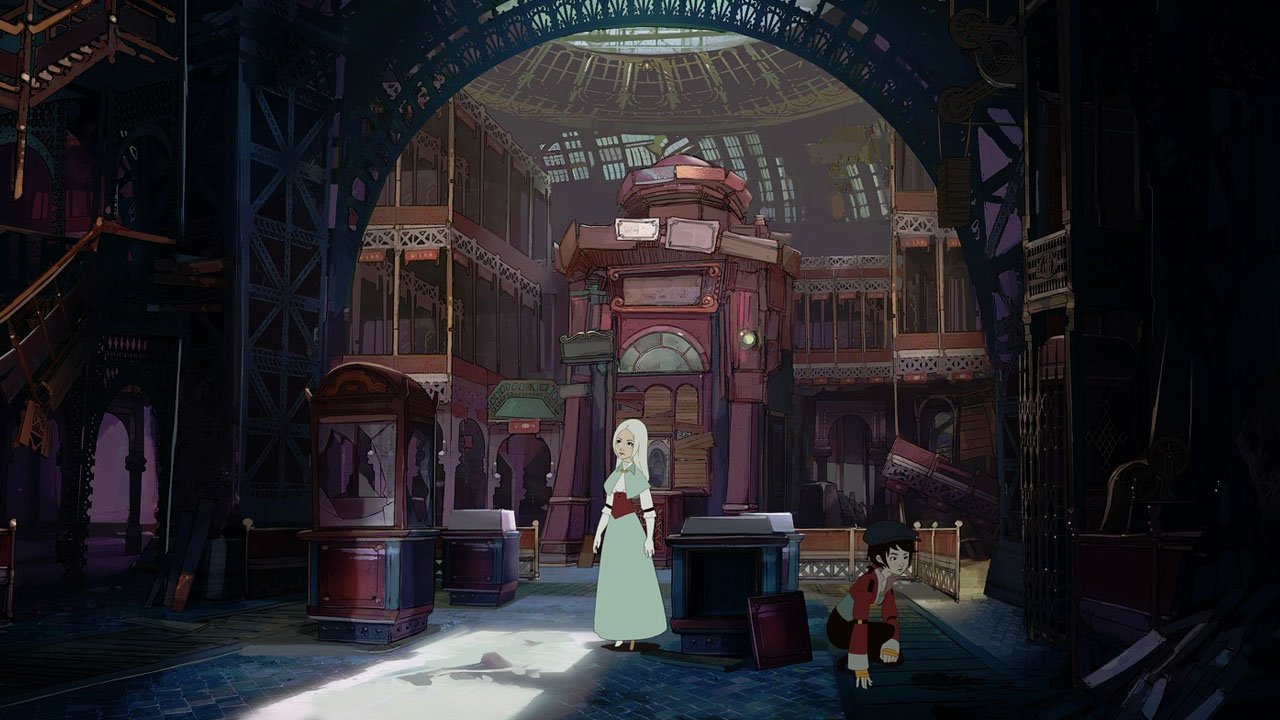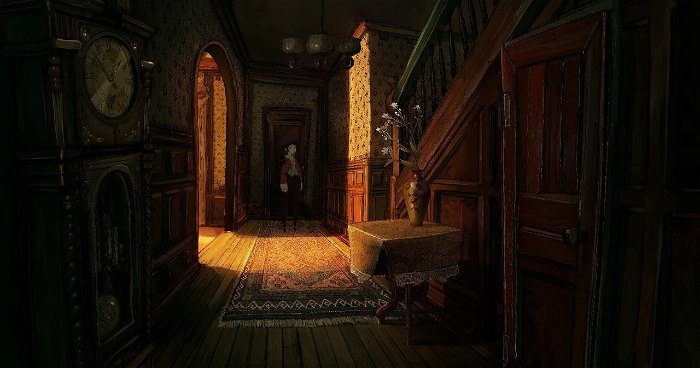According to Daedalic games, the 1851 Great World Exhibition changed things. A fictional Victorian town by the seaside, a mixture of Brighton and London, played host to strange, otherworldly displays. A group of scientists embroiled in criminal activities, claiming to have sold their souls to the devil took hold of the town. Two decades passed, and the men continued their reign. Then someone began murdering the so called Devil’s Men. A woman named Adelaide becomes involved when she witnesses the death of one of the coterie. Emily, a prominent and potentially dangerous gang leader, is the only one who can help.
I’m intrigued. Hungry to learn more, I contacted Kevin Mentz, the author of Daedalic’s upcoming adventure game The Devil’s Men. It features a pair of women as leads, each taking their turn to drive the narrative forward at the hands of the player. What one hand does will affect the other in this interesting take on the genre.
On the Setting
The technology associated with the titular group of scientists has been repeatedly described as being “steampunk” in nature. To hear Mentz tell it, things in the town begin in a relatively straightforward and historically familiar vibe. Artifacts exist somewhere, but are of little concern to most folk. That changes as the story moves: “The deeper you delve into their world the more steampunky the story gets. The 19th century was a time of transition, of industrialization, of modern urbanization, etc. So in our version of that time, I wanted to show that transition also as a transition from a historically somehow real era into something fantastical. You could describe it as the origin story of a new steampunk universe.”
“The reason why I [chose a steampunk setting] was first and foremost the pure joy of inventing such a world. I always like to play around with tropes and clichés and genres in general and find a fresh and interesting take on them. In Memoria I tried to bend classical Hero Fantasy as far as I could without alienating fans of the genre. This time I want the cool stuff from steampunk, the historical and literary references, the play with alternate history, the strangeness and the classiness.
On the Women
Our protagonists have been introduced before, but I wanted to know more about their personalities and how they’ll factor into proceedings. The first is a street thug. Emily is at the helm of a band of misfits and strays taking shelter in remains of the Great World Exhibition. “The other kids fear her because she is the only one of them with blood on her hands.” She has a reputation and somewhat of a sordid past, but it’s left to the player to decide how they want her personality and position amongst her peers to play out.
“For example, she can act cold-hearted and dangerous to keep her followers in line or she could show a more caring side, but that might also make herself more vulnerable to the attacks of potential rivals. Story concept wise she is a fully fleshed out character with certain traits and characteristics, but you, as the player, decide what part of her personality stays hidden and what she shows openly.”
Adelaide’s character develops in the same way. We know who she is when we take control: the daughter of an absent father of great stature as a detective. Her happy childhood and middle class security has been swept away, thrusting her into a life of poverty and vagrancy.
“Her experiences there taught her to be cautious and distrustful. […] She is sensitive, smart and witty, but also very self-conscious. Once again it is up to the player how this kind of character behaves, who she will trust and befriend and what sacrifices she is willing to make.”
“It’s been suggested that casting women in lead roles is financially unsound.”
It’s been suggested that casting women in lead roles is financially unsound. With The Devil’s Men Mentz seems to be shrugging off the notion in favor of his tale. “Daedalic is very lucky to have a publisher like Eurovideo who understands and trusts our artistic vision for a game. The Deponia series was unconventional in a very different way, and still sold very well internationally, so they do have reason to trust that we know what we are doing. So when I first pitched the concept to them I was asked only once whether it would be possible to change one of the two women into a man. I hesitantly answered that it could be done, but that it would change the entire story if either Adelaide or Emily weren’t in there. And they accepted that.”
He went on to express a desire for female protagonists in games to become a non-issue. “Having said all that I do hope that having an all-female leading cast in a game should not remain something you could call “unconventional” in the future – rather just like in books and films a regular choice for any developer to make for their game.” If the positive reaction to the matter that Daedalic received at E3 last month is any indication, we’re making strides in this direction.
On Technical Stuff
While it’s not obvious when viewing the game in still, The Devil’s Men uses three dimensional backdrops for its scenes. Daedalic is using Unity 3D and an in-house middleware called “Mynos”, to achieve a different look for this title. “Traditionally, adventure games tend to have very static scenes and not much variety when it comes to camera work. We wanted to change that, add more depth to locations and enable a more fluent camera allowing for zooms, pans and generally what people like to call ‘more cinematic’ aesthetics. It looks cooler.”
This comes at a price, of course, though it’s one that Daedalic has deemed worth paying. “Originally it took us between one or two weeks to get a 2D backdrop ready for implementation into the engine. Now, with 3D you can double or triple the working hours. You need to model the scene and texture it and flesh out parts of the room that only come into view when the camera shifts in a specific way. So 3D is definitely more expensive than 2D, especially when you want to attain the same level of detail and quality.”
On Choice
Conspicuous player choices and their consequences can be tricky business to feature. Everybody incorporates them differently, so I was curious what kind of effects Mentz and co. are planning around theirs. “There are big decisions that can lead to different puzzles or scenes, while others may only influence the way a certain non-player-character thinks about Emily or Adelaide. Some decisions are obvious, others are so subtle, that at first you might not even realize that you changed something.”
He describes a pair of scenes where Emily and a comrade are escaping the authorities. One involves small, relatively insignificant decisions that will affect how this other character regards her : he could continue to question her authority or learn respect. The second scene offers you a choice with greater impact on Emily’s standing in the gang. Will she sacrifice herself or willingly place her accomplice in danger? “You’re probably less likely to risk his health if he was nice to you before.”
“[…] the first scene only offers varying context and motivation for the entire situation, whereas the decision in the second scene will influence a great deal of Emily’s situation. […] Both have their relevance for the player and are important to consider, because you never really know what is the former and what turns out to be the latter.”
These consequences are not limited to side characters. Sometimes the interests of the two protagonists will conflict, and your actions with one can cause direct harm for the other. Mentz referenced a scene where Adelaide is assisting a police inspector in his casing of a crime scene. “During the investigation she finds evidence pointing to Emily as part of that specific crime. Adelaide can now decide whether to show this evidence to the inspector, thus helping her investigation, but harming Emily in the long run, or she can forge evidence and lead the policeman on a false trail. In that case the investigation gets sabotaged, but Emily will have an advantage later on.” This friction is going to be a recurring problem. “In that regard calling a decision ‘good’ or ‘bad’ is always a matter of perspective.”
Events near the beginning of the game will play out in similar sequence regardless of what you do, but this changes as you progress. “Gradually you will realize that your decisions influence more and more details that add up to larger variations to the story, making the second half of the game more and more unique.”
“Mostly the differences are related to different character developments, relationships and what you find out about the background story in general. Graphics-wise, though, you will always visit the same locations, but in different contexts and sometimes even with different puzzles.”
On Being German
German gaming culture is very fond of its adventure games. Mentz says that his home market is far easier to ply than that in the larger pool of American players, but they’re taking motions in the rest of the world one step at a time. “We do have a lot of fans in the rest of Europe and even in South and Middle America.[…] Deponia sold very well and we are planning to build up on that success.”
Occasionally, though, the leap abroad causes some problems. While good translation can make people laugh even if the original German joke or pun doesn’t carry across, others may simply be inaccessible to foreign players. “In fact Deponia is a word play on the German word ‘deponie’ (junk yard), but we couldn’t translate it, because we didn’t want to change the title of the game for the international market. So in this case the joke was deliberately lost.”





